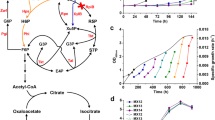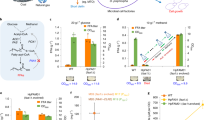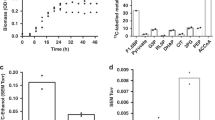Abstract
Methanol, an organic one-carbon (C1) compound, represents an attractive alternative carbon source for microbial fermentation. Despite considerable advancements in methanol utilization by prokaryotes such as Escherichia coli, engineering eukaryotic model organisms such as Saccharomyces cerevisiae into synthetic methylotrophs remains challenging. Here, an engineered module circuit strategy combined with adaptive laboratory evolution was applied to engineer S. cerevisiae to use methanol as the sole carbon source. We revealed that the evolved glyoxylate-based serine pathway plays an important role in methanol-dependent growth by promoting formaldehyde assimilation. Further, we determined that the isoprenoid biosynthetic pathway was upregulated, resulting in an increased concentration of squalene and ergosterol in our evolved strain. These changes could potentially alleviate cell membrane damage in the presence of methanol. This work sets the stage for expanding the potential of exploiting S. cerevisiae as a potential organic one-carbon platform for biochemical or biofuel production.

This is a preview of subscription content, access via your institution
Access options
Access Nature and 54 other Nature Portfolio journals
Get Nature+, our best-value online-access subscription
$29.99 / 30 days
cancel any time
Subscribe to this journal
Receive 12 digital issues and online access to articles
$119.00 per year
only $9.92 per issue
Buy this article
- Purchase on Springer Link
- Instant access to full article PDF
Prices may be subject to local taxes which are calculated during checkout








Similar content being viewed by others
Data availability
The RNA-seq raw data can be downloaded from the Genome Expression Omnibus website (https://www.ncbi.nlm.nih.gov/geo/) with series no. GSE173802. The accession no. for the genome sequence data of evolved strains reported in this paper is [NCBI.SRA]:[PRJNA728351]. All other data that support the findings in this study are available on request. All plasmids and strains used in this study can be obtained from Z.B. under a material transfer agreement. Source Data are provided with this paper.
References
Jiang, W. et al. Metabolic engineering strategies to enable microbial utilization of C1 feedstocks. Nat. Chem. Biol. 17, 845–855 (2021).
Szima, S. & Cormos, C.-C. Improving methanol synthesis from carbon-free H2 and captured CO2: a techno-economic and environmental evaluation. J. CO2 Util. 24, 555–563 (2018).
Zhang, W. et al. Guidance for engineering of synthetic methylotrophy based on methanol metabolism in methylotrophy. RSC Adv. 7, 4083–4091 (2017).
Ochsner, A. M., Sonntag, F., Buchhaupt, M., Schrader, J. & Vorholt, J. A. Methylobacterium extorquens: methylotrophy and biotechnological applications. Appl. Microbiol. Biotechnol. 99, 517–534 (2015).
Chen, F. Y.-H., Jung, H.-W., Tsuei, C.-Y. & Liao, J. C. Converting Escherichia coli to a synthetic methylotroph growing solely on methanol. Cell 182, 933–946 (2020).
Gleizer, S. et al. Conversion of Escherichia coli to generate all biomass carbon from CO2. Cell 179, 1255–1263 (2019).
Tsao, G. T. Annual Reports on Fermentation Processes (Elsevier, 2014).
Patel, S. K. et al. Hierarchical macroporous particles for efficient whole-cell immobilization: application in bioconversion of greenhouse gases to methanol. ACS Appl. Mater. Interfaces 11, 18968–18977 (2019).
Conrado, R. J. & Gonzalez, R. Envisioning the bioconversion of methane to liquid fuels. Science 343, 621–623 (2014).
Meunier, N., Chauvy, R., Mouhoubi, S., Thomas, D. & De Weireld, G. Alternative production of methanol from industrial CO2. Renew. Energy 146, 1192–1203 (2020).
Cai, P., Gao, J. & Zhou, Y. CRISPR-mediated genome editing in non-conventional yeasts for biotechnological applications. Microb. Cell Factories 18, 63 (2019).
Woolston, B. M., King, J. R., Reiter, M., Van Hove, B. & Stephanopoulos, G. Improving formaldehyde consumption drives methanol assimilation in engineered E. coli. Nat. Commun. 9, 1–12 (2018).
Whitaker, W. B. et al. Engineering the biological conversion of methanol to specialty chemicals in Escherichia coli. Metab. Eng. 39, 49–59 (2017).
Tuyishime, P. et al. Engineering Corynebacterium glutamicum for methanol-dependent growth and glutamate production. Metab. Eng. 49, 220–231 (2018).
Price, J. V., Chen, L., Whitaker, W. B., Papoutsakis, E. & Chen, W. Scaffoldless engineered enzyme assembly for enhanced methanol utilization. Proc. Natl Acad. Sci. USA 113, 12691–12696 (2016).
Yu, H. & Liao, J. C. A modified serine cycle in Escherichia coli coverts methanol and CO2 to two-carbon compounds. Nat. Commun. 9, 3992 (2018).
Meyer, F. et al. Methanol-essential growth of Escherichia coli. Nat. Commun. 9, 1508 (2018).
Kim, S. et al. Growth of E. coli on formate and methanol via the reductive glycine pathway. Nat. Chem. Biol. 16, 538–545 (2020).
Keller, P. et al. Generation of an Escherichia coli strain growing on methanol via the ribulose monophosphate cycle. Nat. Commun. 13, 5243 (2022).
Attfield, P. V. Stress tolerance: the key to effective strains of industrial baker’s yeast. Nat. Biotechnol. 15, 1351–1357 (1997).
Nielsen, J. Yeast systems biology: model organism and cell factory. Biotechnol. J. 14, e1800421 (2019).
Lourens-Hattingh, A. & Viljoen, B. C. Growth and survival of a probiotic yeast in dairy products. Food Res. Int. 34, 791–796 (2001).
Wang, G., Huang, M. & Nielsen, J. Exploring the potential of Saccharomyces cerevisiae for biopharmaceutical protein production. Curr. Opin. Biotechnol. 48, 77–84 (2017).
Nielsen, J., Larsson, C., van Maris, A. & Pronk, J. Metabolic engineering of yeast for production of fuels and chemicals. Curr. Opin. Biotechnol. 24, 398–404 (2013).
Yasokawa, D. et al. Toxicity of methanol and formaldehyde towards Saccharomyces cerevisiae as assessed by DNA microarray analysis. Appl. Biochem. Biotechnol. 160, 1685–1698 (2010).
Stanley, D., Bandara, A., Fraser, S., Chambers, P. J. & Stanley, G. A. The ethanol stress response and ethanol tolerance of Saccharomyces cerevisiae. J. Appl. Microbiol. 109, 13–24 (2010).
Zhou, Y. J. et al. Production of fatty acid-derived oleochemicals and biofuels by synthetic yeast cell factories. Nat. Commun. 7, 11709 (2016).
Parapouli, M., Vasileiadis, A., Afendra, A. S. & Hatziloukas, E. Saccharomyces cerevisiae and its industrial applications. AIMS Microbiol. 6, 1–31 (2020).
Dai, Z. et al. Metabolic construction strategies for direct methanol utilization in Saccharomyces cerevisiae. Bioresour. Technol. 245, 1407–1412 (2017).
Espinosa, M. I., Williams, T. C., Pretorius, I. S. & Paulsen, I. T. Benchmarking two Saccharomyces cerevisiae laboratory strains for growth and transcriptional response to methanol. Synth. Syst. Biotechnol. 4, 180–188 (2019).
Espinosa, M. I. et al. Adaptive laboratory evolution of native methanol assimilation in Saccharomyces cerevisiae. Nat. Commun. 11, 5564 (2020).
Inan, M. & Meagher, M. M. Non-repressing carbon sources for alcohol oxidase (Aox1) promoter of Pichia pastoris. J. Biosci. Bioeng. 92, 585–589 (2001).
Cotton, C. A., Claassens, N. J., Benito-Vaquerizo, S. & Bar-Even, A. Renewable methanol and formate as microbial feedstocks. Curr. Opin. Biotechnol. 62, 168–180 (2020).
Zhan, C. et al. Strategies and challenges with the microbial conversion of methanol to high-value chemicals. Biotechnol. Bioeng. 118, 3655–3668 (2021).
Flamholz, A., Noor, E., Bar-Even, A. & Milo, R. eQuilibrator—the biochemical thermodynamics calculator. Nucleic Acids Res. 40, D770–D775 (2012).
Rußmayer, H. et al. Systems-level organization of yeast methylotrophic lifestyle. BMC Biol. 13, 80 (2015).
Vizeacoumar, F. J., Torres-Guzman, J. C., Bouard, D., Aitchison, J. D. & Rachubinski, R. A. Pex30p, Pex31p, and Pex32p form a family of peroxisomal integral membrane proteins regulating peroxisome size and number in Saccharomyces cerevisiae. Mol. Biol. Cell 15, 665–677 (2004).
Zhou, Y. J. et al. Harnessing yeast peroxisomes for biosynthesis of fatty-acid-derived biofuels and chemicals with relieved side-pathway competition. J. Am. Chem. Soc. 138, 15368–15377 (2016).
Al-Saryi, N. A. et al. Two NAD-linked redox shuttles maintain the peroxisomal redox balance in Saccharomyces cerevisiae. Sci. Rep. 7, 11868 (2017).
Ozimek, P. et al. Pyruvate carboxylase is an essential protein in the assembly of yeast peroxisomal oligomeric alcohol oxidase. Mol. Biol. Cell 14, 786–797 (2003).
Ozimek, P. Z., Klompmaker, S. H., Visser, N., Veenhuis, M. & Van Der Klei, I. J. The transcarboxylase domain of pyruvate carboxylase is essential for assembly of the peroxisomal flavoenzyme alcohol oxidase. FEMS Yeast Res. 7, 1082–1092 (2007).
Watanabe, S., Kodaki, T. & Makino, K. Complete reversal of coenzyme specificity of xylitol dehydrogenase and increase of thermostability by the introduction of structural zinc. J. Biol. Chem. 280, 10340–10349 (2005).
Li, X. et al. Metabolic network remodelling enhances yeast’s fitness on xylose using aerobic glycolysis. Nat. Catal. 4, 783–796 (2021).
Li, X., Chen, Y. & Nielsen, J. Harnessing xylose pathways for biofuels production. Curr. Opin. Biotechnol. 57, 56–65 (2019).
Hu, Z. et al. Recent advances in ergosterol biosynthesis and regulation mechanisms in Saccharomyces cerevisiae. Indian J. Microbiol. 57, 270–277 (2017).
Khan, M. S. A., Ahmad, I. & Cameotra, S. S. Phenyl aldehyde and propanoids exert multiple sites of action towards cell membrane and cell wall targeting ergosterol in Candida albicans. Amb. Express 3, 1–16 (2013).
Veelders, M. et al. Structural basis of flocculin-mediated social behavior in yeast. Proc. Natl Acad. Sci. USA 107, 22511–22516 (2010).
Gstaiger, M. et al. Control of nutrient-sensitive transcription programs by the unconventional prefoldin URI. Science 302, 1208–1212 (2003).
Renwick, S. B., Snell, K. & Baumann, U. The crystal structure of human cytosolic serine hydroxymethyltransferase: a target for cancer chemotherapy. Structure 6, 1105–1116 (1998).
Denis, V. & Daignan-Fornier, B. Synthesis of glutamine, glycine and 10-formyl tetrahydrofolate is coregulated with purine biosynthesis in Saccharomyces cerevisiae. Mol. Gen. Genet. MGG 259, 246–255 (1998).
Kastanos, E. K., Woldman, Y. Y. & Appling, D. R. Role of mitochondrial and cytoplasmic serine hydroxymethyltransferase isozymes in de novo purine synthesis in Saccharomyces cerevisiae. Biochemistry 36, 14956–14964 (1997).
Cox, R. J. Polyketides, proteins and genes in fungi: programmed nano-machines begin to reveal their secrets. Org. Biomol. Chem. 5, 2010–2026 (2007).
Yang, D. et al. Repurposing type III polyketide synthase as a malonyl-CoA biosensor for metabolic engineering in bacteria. Proc. Natl. Acad. Sci. USA 115, 9835–9844 (2018).
Krog, A. et al. Methylotrophic Bacillus methanolicus encodes two chromosomal and one plasmid born NAD+ dependent methanol dehydrogenase paralogs with different catalytic and biochemical properties. PLoS One 8, e59188 (2013).
Jordà, J. et al. Metabolic flux profiling of recombinant protein secreting Pichia pastoris growing on glucose: methanol mixtures. Microb. Cell Factories 11, 1–14 (2012).
Jordà, J., De Jesus, S. S., Peltier, S., Ferrer, P. & Albiol, J. Metabolic flux analysis of recombinant Pichia pastoris growing on different glycerol/methanol mixtures by iterative fitting of NMR-derived 13C-labelling data from proteinogenic amino acids. Nat. Biotechnol. 31, 120–132 (2014).
Wakayama, K. et al. Regulation of intracellular formaldehyde toxicity during methanol metabolism of the methylotrophic yeast Pichia methanolica. J. Biosci. Bioeng. 122, 545–549 (2016).
Siegel, J. B. et al. Computational protein design enables a novel one-carbon assimilation pathway. Proc. Natl Acad. Sci. USA 112, 3704–3709 (2015).
Lu, X. et al. Constructing a synthetic pathway for acetyl-coenzyme A from one-carbon through enzyme design. Nat. Commun. 10, 1378 (2019).
Claassens, N. J., Burgener, S., Vogeli, B., Erb, T. J. & Bar-Even, A. A critical comparison of cellular and cell-free bioproduction systems. Curr. Opin. Biotechnol. 60, 221–229 (2019).
Singh, A. K., Kishore, G. M. & Pakrasi, H. B. Emerging platforms for co-utilization of one-carbon substrates by photosynthetic organisms. Curr. Opin. Biotechnol. 53, 201–208 (2018).
Hong, K. K., Vongsangnak, W., Vemuri, G. N. & Nielsen, J. Unravelling evolutionary strategies of yeast for improving galactose utilization through integrated systems level analysis. Proc. Natl. Acad. Sci. USA 108, 12179–12184 (2011).
Zhu, Z. W. et al. Multidimensional engineering of Saccharomyces cerevisiae for efficient synthesis of medium-chain fatty acids. Nat. Catal. 3, 64–74 (2020).
Azachi, M., Henis, Y., Shapira, R. & Oren, A. The role of the outer membrane in formaldehyde tolerance in Escherichia coli VU3695 and Halomonas sp. Mac. Microbiol. 142, 1249–1254 (1996).
Liu, G., Chen, Y., Færgeman, N.J. & Nielsen, J. Elimination of the last reactions in ergosterol biosynthesis alters the resistance of Saccharomyces cerevisiae to multiple stresses. FEMS Yeast Res. 17, fox063 (2017).
Vanegas, J. M., Contreras, M. F., Faller, R. & Longo, M. L. Role of unsaturated lipid and ergosterol in ethanol tolerance of model yeast biomembranes. Biophys. J. 102, 507–516 (2012).
Liu, Q. et al. Rewiring carbon metabolism in yeast for high level production of aromatic chemicals. Nat. Commun. 10, 1–13 (2019).
Naito Y., Hino, K., Bono, H. & Ui-Tei, K. CRISPRdirect: Software for Designing CRISPR/Cas Guide RNA with Reduced Off-Target Sites (CRISPRdirect, 2015); http://crispr.dbcls.jp/
Qin, J. et al. Modular pathway rewiring of Saccharomyces cerevisiae enables high-level production of l-ornithine. Nat. Commun. 6, 224 (2015).
Krivoruchko, A., Serrano-Amatriain, C., Chen, Y., Siewers, V. & Nielsen, J. Improving biobutanol production in engineered Saccharomyces cerevisiae by manipulation of acetyl-CoA metabolism. J. Ind. Microbiol. Biotechnol. 40, 1051–1056 (2013).
Evers, M. E., Harder, W. & Veenhuis, M. In vitro dissociation and re-assembly of peroxisomal alcohol oxidases of Hansenula polymorpha and Pichia pastoris. FEBS Lett. 368, 293–296 (1995).
Couderc, R. & Baratti, J. Oxidation of methanol by the yeast, Pichia pastoris. Purification and properties of the alcohol oxidase. Agric. Biol. Chem. 44, 2279–2289 (1980).
Müller, J. E. et al. Engineering Escherichia coli for methanol conversion. Metab. Eng. 28, 190–201 (2015).
Zhan, C. et al. The Pichia pastoris transmembrane protein GT1 is a glycerol transporter and relieves the repression of glycerol on AOX1 expression. FEMS Yeast Res. 16, fow033 (2016).
Caspeta, L. et al. Altered sterol composition renders yeast thermotolerant. Science 346, 75–78 (2014).
Baidoo, E.E., Wang, G., Joshua, C.J., Benites, V.T. & Keasling, J.D. in Microbial Metabolomics 209–224 (Springer, 2019).
Kim, J. et al. Engineering Saccharomyces cerevisiae for isoprenol production. Metab. Eng. 64, 154–166 (2021).
Yu, T. et al. Reprogramming yeast metabolism from alcoholic fermentation to lipogenesis. Cell 174, 1549–1558 (2018).
Deatherage, D.E. & Barrick, J.E. in Engineering and Analyzing Multicellular Systems 165–188 (Springer, 2014).
Väremo, L., Nielsen, J. & Nookaew, I. Enriching the gene set analysis of genome-wide data by incorporating directionality of gene expression and combining statistical hypotheses and methods. Nucleic Acids Res. 41, 4378–4391 (2013).
Saccharomyces Genome Database (Stanford University, 2023); http://www.yeastgenome.org
Incha, M. R. et al. Leveraging host metabolism for bisdemethoxycurcumin production in Pseudomonas putida. Metab. Eng. Commun. 10, e00119 (2020).
Acknowledgements
This work was supported by the National Natural Science Foundation of China (grant no. 21908077 to C.Z.), the National Key R&D Program of China (grant no. 2021YFC2100203 to Y.Y.), the national first-class discipline program of Light Industry Technology and Engineering (grant no. LITE2018-24), the 111 Project (111-2-06) and the DOE Joint BioEnergy Institute (https://www.jbei.org), and funded by the US Department of Energy, Office of Science, Office of Biological, and Environmental Research through contract no DE-AC02-05CH11231 between Lawrence Berkeley National Laboratory and the US Department of Energy.
Author information
Authors and Affiliations
Contributions
C.Z. conceived the study. C.Z. and X.L. designed the study, performed the experiments and data processing, and analysed the data. Z.B., J.D.K., J.N. and Y.C. supervised the project. E.E.K.B. performed the 13C-labelled experiments and analysed the data. S.W. conducted scanning electron microscopy experiment. Y.W. was involved in constructing some of the plasmids needed for the study. C.Z. and X.L. wrote the manuscript. J.D.K., G.L. and Y.L. revised the manuscript. Y.Y., Y.S. and G.W. contributed to the review, editing and final approval of the manuscript. They provided valuable insights and suggestions to improve the quality of the research paper.
Corresponding authors
Ethics declarations
Competing interests
J.D.K. has financial interests in Amyris, Ansa Biotechnologies, Apertor Pharma, Berkeley Yeast, Cyklos Materials, Demetrix, Lygos, Napigen, ResVita Bio, and Zero Acre Farms. None of these companies work in the field explored in this study. All other authors declare no competing interests.
Peer review
Peer review information
Nature Catalysis thanks Elke Nevoigt and the other, anonymous, reviewer for their contribution to the peer review of this work.
Additional information
Publisher’s note Springer Nature remains neutral with regard to jurisdictional claims in published maps and institutional affiliations.
Supplementary information
Supplementary Information
Supplementary Figs. 1–26, Tables 1–6, Notes 1–4 and Methods.
Supplementary Data
Source data for Supplemetary Figs. 4–24
Source data
Source Data Fig. 1
Statistical Source Data for Fig. 1.
Source Data Fig. 2
Statistical Source Data for Fig. 2.
Source Data Fig. 3
Statistical Source Data for Fig. 3.
Source Data Fig. 4
Statistical Source Data for Fig. 4.
Source Data Fig. 5
Statistical Source Data for Fig. 5.
Source Data Fig. 6
Statistical Source Data for Fig. 6.
Source Data Fig. 7
Statistical Source Data for Fig. 7.
Source Data Fig. 8
Statistical Source Data for Fig. 8.
Rights and permissions
Springer Nature or its licensor (e.g. a society or other partner) holds exclusive rights to this article under a publishing agreement with the author(s) or other rightsholder(s); author self-archiving of the accepted manuscript version of this article is solely governed by the terms of such publishing agreement and applicable law.
About this article
Cite this article
Zhan, C., Li, X., Lan, G. et al. Reprogramming methanol utilization pathways to convert Saccharomyces cerevisiae to a synthetic methylotroph. Nat Catal 6, 435–450 (2023). https://doi.org/10.1038/s41929-023-00957-w
Received:
Accepted:
Published:
Issue Date:
DOI: https://doi.org/10.1038/s41929-023-00957-w
This article is cited by
-
Engineering strategies for enhanced heterologous protein production by Saccharomyces cerevisiae
Microbial Cell Factories (2024)
-
Strategies to increase the robustness of microbial cell factories
Advanced Biotechnology (2024)
-
The potential of CO2-based production cycles in biotechnology to fight the climate crisis
Nature Communications (2023)



